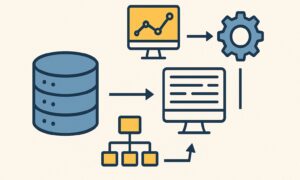Data has become the lifeblood of modern enterprises, fueling decisions from the boardroom to daily operations. Behind the scenes, there’s a critical set of processes making this possible – Extract, Transform, and Load (ETL). These processes might not grab headlines, but they’re absolutely essential to successful data warehousing. I’ve worked with many clients who initially underestimated ETL’s importance only to realize it can make or break their entire data strategy. If you’re looking to implement a robust solution, partnering with an experienced data warehousing company can save countless headaches down the road.
What Actually Happens in ETL?
I remember my first major data warehouse project back in 2018. The client, a mid-sized retailer, couldn’t understand why we were spending so much time on ETL planning. “Just get the data in there,” they kept saying. Six months later, when they could finally trust their reports enough to make inventory decisions, they understood.
ETL isn’t just moving data from point A to point B. It’s a carefully orchestrated process:
Extraction: Getting Data from Source Systems
This first step sounds simple but rarely is. You’re likely pulling data from:
- Legacy systems that weren’t designed for reporting
- Cloud applications with inconsistent APIs
- Spreadsheets that different departments have formatted their own way
- Partner systems over which you have limited control
I’ve seen extraction processes crash because someone added a single character to a field name in a source system. The real challenge is building extractions robust enough to handle these inevitable changes while still maintaining performance.
Most extraction methods fall into two approaches:
- Full extraction – Pulling all the data every time (simple but increasingly impractical as data volumes grow)
- Incremental extraction – Only grabbing what’s changed (more efficient but requires careful change tracking)
Transformation: Where the Magic Happens
Transformation is where raw data becomes valuable information. In my experience, this phase typically consumes 60-70% of ETL development time.
A client in healthcare once showed me their “patient demographics” data from five different systems. Same patients, but names formatted differently, conflicting birth dates, different address formats – a complete mess. Our transformation process had to establish “golden records” through sophisticated matching algorithms.
Common transformations include:
- Converting codes to meaningful business terms
- Standardizing date formats (why does everyone use different formats?)
- Deduplicating records (harder than it sounds!)
- Validating data against business rules
- Calculating derived fields
- Aggregating detailed records into summary information
Good transformation processes don’t just move data; they improve it.
Loading: The Final Mile
Loading transformed data seems straightforward, but timing and method matter greatly. I’ve seen well-designed warehouses brought to their knees by poorly planned loading processes.
The approach varies based on requirements:
- Full loads – Completely replacing tables (simpler but time-consuming)
- Incremental loads – Adding only new or changed data (faster but requires careful management)
- Micro-batch loading – Small, frequent updates (great for near real-time needs)
One manufacturing client needed 24/7 warehouse availability but also had massive overnight data volumes. We implemented a sophisticated partitioning strategy that allowed loading without disrupting users – a lifesaver for their global operation.
Why ETL Makes or Breaks Your Data Warehouse
I’ve witnessed brilliant data warehouse designs fail because of poor ETL implementation. Here’s why ETL matters so much:
It’s Your Data Quality Gatekeeper
Garbage in, garbage out. This cliché exists for a reason. ETL represents your best opportunity to identify and fix data quality issues before they contaminate your entire warehouse.
A financial services client once discovered that thousands of transactions had been miscategorized for months because their ETL process lacked proper validation. The resulting cleanup took weeks and eroded trust in their reporting.
Effective ETL includes:
- Data profiling to understand what you’re dealing with
- Quality checks at multiple stages
- Clear exception handling
- Reconciliation with source systems
It Breaks Down Data Silos
Most organizations I’ve worked with have data scattered across dozens of systems that don’t talk to each other. ETL processes integrate these islands of information.
I recall a retail client who couldn’t understand why their customer marketing campaigns performed poorly. When we built ETL processes that connected online behavior with in-store purchases, they discovered they’d been targeting the wrong segments entirely. Their ROI improved by 40% once they had the complete customer picture.
It Preserves Historical Context
Operational systems typically focus on current state, but business intelligence requires historical perspective. Well-designed ETL captures and preserves changes over time.
A manufacturing client needed to understand why product quality had declined. Their ERP system only showed current specifications, but our ETL processes had been tracking specification changes for years. This historical perspective revealed that a seemingly minor material change had significant quality implications.
Real-World ETL Challenges I’ve Encountered
After implementing dozens of data warehouses, I’ve found these challenges appear consistently:
Performance Bottlenecks
As data volumes grow, ETL processes that once completed in minutes can stretch to hours or even days. I worked with an e-commerce company whose ETL window grew from 2 hours to 12 hours over just 18 months as their business expanded.
Solutions often include:
- Partitioning large tables
- Implementing parallel processing
- Switching to incremental approaches
- Pre-aggregating where appropriate
- Moving transformation logic to database procedures
Changing Source Systems
Just when you’ve got everything running smoothly, someone upgrades a source system or implements a new one. I’ve had weekend plans ruined more than once by unexpected source changes!
A healthcare client once had their EHR vendor push an update that completely changed their database structure. We had to rebuild 60% of their ETL processes in a single weekend.
Defensive strategies include:
- Building abstraction layers between sources and ETL
- Implementing comprehensive monitoring
- Developing strong change management processes
- Maintaining detailed documentation
Business Rule Evolution
Business rules embedded in transformation logic need frequent updates. What counts as a “qualified lead” or an “active customer” changes regularly in most organizations.
One retailer I worked with changed their return policy, which affected how we calculated several KPIs. Having transformation logic clearly documented saved us countless hours when implementing the changes.
Best Practices from the Trenches
After years of ETL development, here’s what I’ve found works best:
Design for Resilience, Not Just Performance
I’ve seen too many ETL processes optimized for speed that break at the slightest hiccup. Build for the real world:
- Implement comprehensive error handling
- Create self-healing processes where possible
- Log everything (you’ll thank yourself later)
- Plan for partial failures
- Test with bad data, not just ideal data
Embrace Incremental Processing
The days of nightly full refreshes are ending for most organizations. Implement change data capture (CDC) where possible to track and process only what’s changed.
A retail banking client reduced their processing window from 8 hours to 45 minutes by switching to incremental processing, enabling more frequent updates throughout the business day.
Metadata is Your Friend
Document everything about your ETL processes:
- Source system details
- Transformation rules
- Business logic explanations
- Data lineage
- Update frequencies
- Dependencies
This documentation isn’t just nice to have—it’s essential when troubleshooting issues or making changes.
The ETL Landscape is Evolving
The world of ETL continues to evolve rapidly:
The Rise of ELT
With cloud data warehouses offering massive processing power, many organizations now load raw data first and transform it in-place (Extract, Load, Transform). This approach offers flexibility but requires careful governance.
I helped a media company transition from traditional ETL to ELT, dramatically reducing their development time for new data sources while maintaining data quality through rigorous post-load validation.
Real-Time Data Integration
The batch window is disappearing as businesses demand more immediate insights. Modern ETL often includes streaming components that process data continuously.
One retail client implemented near-real-time inventory updates across 200+ stores, reducing out-of-stock situations by monitoring sales patterns throughout the day rather than relying on overnight processing.
The DataOps Revolution
ETL development is increasingly adopting DevOps practices:
- Version control for ETL processes
- Automated testing of data pipelines
- Continuous integration/deployment
- Infrastructure as code
These approaches have helped my teams reduce ETL development cycles from months to weeks.
Conclusion
After years in the trenches of data warehousing projects, I’ve come to see ETL as the unsung hero of business intelligence. While dashboards and visualizations get the glory, it’s solid ETL processes that determine whether an organization can truly trust its data.
The landscape continues to evolve with new technologies and approaches, but the fundamental challenges remain: extracting data from diverse sources, transforming it into valuable information, and delivering it where and when it’s needed.
Organizations that invest appropriately in ETL—with the right tools, adequate resources, and proper governance—position themselves to make better decisions based on reliable information. Those that treat ETL as an afterthought often find themselves questioning their reports and rebuilding solutions that should have been properly designed from the start.
Whether you’re just beginning your data warehousing journey or looking to improve existing processes, remember that ETL deserves more attention than it typically receives. Your reports and dashboards are only as good as the data behind them, and ETL is what ensures that foundation is solid.



































